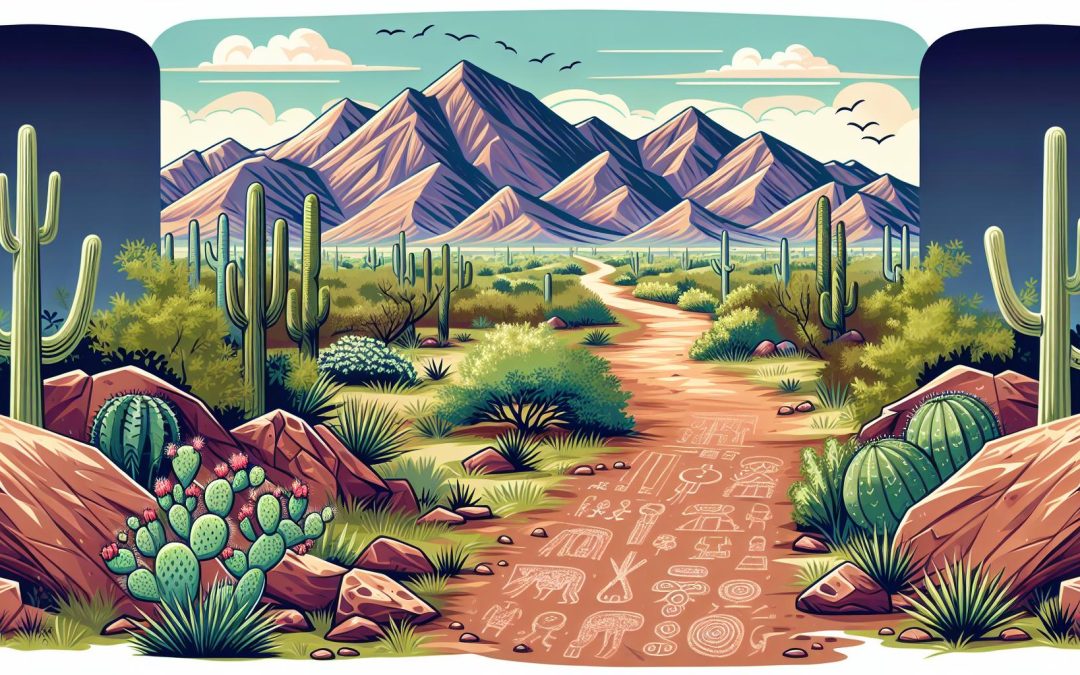Nestled in the heart of Phoenix, Arizona, South Mountain Park and Preserve isn’t just a park; it’s a breathtaking escape into nature. Spanning over 16,000 acres, it’s one of the largest municipally managed parks in the country, and it’s right in my backyard. With its rugged terrain and panoramic views, it’s a paradise for hikers, bikers, and anyone looking to take a break from the city’s hustle and bustle.
I’ve spent countless weekends exploring its myriad of trails, each offering its own unique adventure. From easy strolls to challenging climbs, there’s a path for everyone. And let me tell you, the views from the top? Absolutely worth every step. Whether you’re a seasoned hiker or just looking to enjoy a leisurely walk in the great outdoors, South Mountain Park and Preserve is a destination that should be on everyone’s list.
History of South Mountain Park and Preserve
Stepping back in time, I find South Mountain Park and Preserve’s story as fascinating as its landscapes. It’s incredible to think that what I now see as a vast expanse of pristine desert was once just as cherished and utilized by ancient civilizations. The Hohokam people, who farmed the Phoenix basin, left behind petroglyphs within the park, etching their stories into the boulders and cliff faces.
In 1924, South Mountain Park was designated as a park, making it one of the nation’s oldest. It’s heartwarming to realize this space has been preserved for almost a century, providing countless generations with the joy and beauty of the Arizona desert. The park’s area has grown substantially over the years through various land acquisitions, reaching its current size of over 16,000 acres, making it one of the largest city parks in the United States.
The Civilian Conservation Corps (CCC) played a crucial role in the park’s development during the Great Depression. They constructed more than 40 miles of trails, picnic areas, and the recognizable stone ramadas that blend seamlessly with the natural surroundings. Their hard work laid the foundation for the park’s infrastructure, contributing to its enduring appeal.
Over the years, South Mountain Park and Preserve has evolved, but one thing remains constant: its ability to connect people to nature. Whether it’s through the silently speaking petroglyphs, the trails carved by the CCC, or the panoramic views that sweep across the horizon, this park serves as a bridge across time, linking past, present, and future.
Trail Options for Different Skill Levels

Embarking on a hike at South Mountain Park and Preserve elevates the experience for beginners and seasoned hikers alike. With over 58 miles of trails crisscrossing its expanse, selecting the right one for your skill level isn’t just recommended—it’s essential to fully enjoy what the park has to offer.
For newcomers to hiking or those looking for a more leisurely pace, Judith Tunell Accessible Trail is a perfect choice. It’s not only accessible, ensuring that everyone gets a chance to immerse in nature’s beauty but also offers informational panels along the way. These panels enrich the journey with fascinating insights about the local flora and fauna.
Meanwhile, the Holbert Trail presents a bit more of a challenge and is a hit among intermediate hikers. Spanning approximately 2.5 miles one way, it rewards the effort with unparalleled views of downtown Phoenix. Along the path, hikers are treated to the ancient petroglyphs, a silent testament to the area’s rich history, making it a trail that’s both physically and intellectually rewarding.
Seasoned adventurers looking to test their limits will find their match on the National Trail. Stretching over 14 miles, it spans the park’s entire length, offering a demanding yet rewarding experience with its varied terrain and breathtaking vistas. It’s an opportunity to engage with the landscape intimately, traversing the very heart of South Mountain Preserve.
Regardless of the path chosen, every trail at South Mountain Park promises a unique journey. The variety ensures that all visitors, from casual walkers to serious trekkers, can find a route that not only matches their skill but also enhances their connection to the natural world. Here’s a quick breakdown of the mentioned trails:
| Trail Name | Difficulty Level | Length | Features |
|---|---|---|---|
| Judith Tunell Accessible | Easy | Accessible | Informational panels, accessible path |
| Holbert Trail | Moderate | 2.5 miles (one way) | Downtown views, petroglyphs |
| National Trail | Difficult | 14 miles | Crosses the park, varied terrain, panoramic views |
Flora and Fauna in the Park
Walking through South Mountain Park and Preserve, I’m always amazed by the diverse plant life. It’s like stepping into a vast canvas painted with the vibrant greens of saguaros, paloverde trees, and creosote bushes. These plants aren’t just beautiful; they’re tough survivors, thriving in the harsh desert conditions. Saguaros, with their iconic arms, can live for over 200 years and bloom with white flowers that glow under the moonlight – a sight to behold.
Among this greenery, I’ve encountered a variety of wildlife that calls the park home. It’s not uncommon to spot jackrabbits darting through the underbrush or hear the distinct call of a cactus wren, Arizona’s state bird. These encounters always remind me of the park’s thriving ecosystem. Roadrunners, with their quirky antics, are a delight, while the occasional glimpse of a coyote or javelina provides a thrilling connection to the wild.
The preserve also serves as a habitat for several Species of Reptiles, including the Gila monster and various snakes. While hiking, I always keep an eye out for these creatures, respecting their space and marveling at their adaptation to the desert life. Their presence, though sometimes startling, is a testament to the rich biodiversity of the area.
Birdwatchers and nature enthusiasts find South Mountain Park an unrivaled destination. From the towering peaks to the dry river beds, each biome within the park supports a unique set of flora and fauna. It’s this diversity that makes every visit a new discovery, urging hikers and nature lovers to explore its depths with respect and curiosity.
Tips for Visitors
When planning a trip to South Mountain Park and Preserve, there are a few things I’ve learned that can make your visit more enjoyable and safe.
First and foremost, water is your best friend. Regardless of the season, the arid climate can quickly dehydrate you. I always suggest bringing more water than you think you’ll need. For a standard hike, I recommend at least one gallon per person.
Next, choose your trails wisely. South Mountain Park and Preserve offers a range of trails, from easy strolls to challenging hikes. I advise starting with the easier trails if you’re new to hiking or to desert environments. The Judith Tunell Trail is perfect for families and offers accessible trails with shaded rest areas.
Timing is everything. To avoid the harsh midday heat, I prefer starting my hikes early in the morning or late in the afternoon. Not only is it cooler, but these times also offer the best light for photography enthusiasts. Plus, the golden hours bring out the vibrant colors of the desert, turning the landscape into a breathtaking spectacle.
Wear appropriate clothing and footwear. Lightweight, breathable clothing helps keep you cool, while a good pair of hiking boots will protect your feet from the rugged terrain.
Lastly, but certainly not least, respect the wildlife. Remember, we’re visitors in their home. Keep a safe distance from animals and never feed them. I always pack out what I pack in, ensuring no litter is left behind to harm the park’s inhabitants or detract from its natural beauty.
By following these tips, you’re well on your way to having a memorable and respectful experience at South Mountain Park and Preserve. Whether you’re there to explore the trails, admire the flora and fauna, or simply enjoy the panoramic views, there’s something for everyone in this remarkable desert oasis.
Exploring Beyond the Trails

When I first set foot in South Mountain Park and Preserve, I knew there’d be more to it than just its well-trodden paths. Venturing off the beaten trail, albeit responsibly and within park guidelines, opened my eyes to a world of understated beauty and solitude that’s hard to find on the main paths.
One of the lesser-known aspects of the park is its historical significance. Hidden away from the main trails are remnants of ancient petroglyphs created by the Hohokam people, who once thrived in this region. Discovering these ancient artworks feels like uncovering a secret message from the past, a reminder of the park’s ancient heritage and the lasting connection between land and culture.
Beyond history, the park’s diverse ecosystem flourishes in the quiet corners and hidden valleys away from the crowded trails. This is where I’ve spotted some of the most memorable wildlife, from the Gila monster basking on a sunlit rock to the elusive desert fox darting through the underbrush. And the plants, oh the plants! It’s remarkable how life thrives here, with cacti, wildflowers, and shrubs painting a vibrant picture against the rugged backdrop.
But remember, with the freedom to explore comes responsibility. It’s crucial to minimize our impact by sticking to existing paths wherever possible and never removing artifacts or disturbing wildlife. South Mountain Park and Preserve is a shared treasure, and it’s up to us to keep it pristine for future adventurers.
So, when you visit, take a moment to step off the popular routes. You might just find that these off-the-beaten-path experiences offer a deeper connection to the natural and cultural richness of the preserve. Just be sure to prepare adequately, carry plenty of water, and respect the park’s guidelines – your adventure awaits in these untold stories and hidden gems.
Conclusion
Exploring South Mountain Park and Preserve has been a journey of discovery for me. From the ancient petroglyphs etched into its landscape to the vibrant ecosystems tucked away from the usual paths, every visit unveils something new. I’ve learned the value of treading lightly and embracing the beauty of nature with respect and mindfulness. For those looking to experience the heart and soul of Phoenix’s natural wonders, this park offers a unique glimpse into Arizona’s rich heritage and breathtaking landscapes. Let’s keep its history alive and its trails welcoming for everyone who seeks adventure in the great outdoors.







